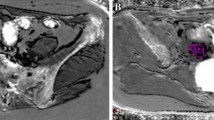Abstract
Objectives
The aim of the study was to investigate the efficiency of susceptibility-weighted magnetic resonance (MR) imaging (SWIs) in differentiating endometriomas from haemorrhagic ovarian cysts.
Materials and methods
Between July 2017 and January 2019, 89 ovarian cystic lesions (57 endometriomas and 32 haemorrhagic cysts) that were identified as complicated cystic lesions on ultrasonography (US) and underwent lower abdominal MRI with susceptibility weighting were retrospectively evaluated. Final diagnoses were obtained with surgical pathological correlation and radiological-clinical follow-up. Two radiologists blinded to the final diagnoses retrospectively reviewed the images in consensus. The signal intensity on T1- and T2-weighted images and curved linear or punctate signal void areas on SWI were noted for the presence of lesions.
Results
Forty of the 57 endometriomas demonstrated the defined MRI criteria, including a cystic hyperintensity on T1-weighted images and hypointensity on T2-weighted images. The remaining 17 lesions did not demonstrate these criteria on conventional MR images. SWI showed punctate or curved linear signal void areas in 53 of 57 endometriomas (92.9%) and none of the haemorrhagic cysts. The sensitivity, specificity and accuracy of SWI in differentiating endometrioma from haemorrhagic cyst were 92.9%, 100.0%, and 95.5%, respectively.
Conclusions
The addition of the SWI sequence to conventional MRI can help distinguish endometriomas from haemorrhagic ovarian cysts.



Similar content being viewed by others
References
Eskenazi B, Warner ML. Epidemiology of endometriosis. Obstet Gynecol Clin North Am. 1997;24:235–58.
Jenkins S, Olive DL, Haney AF. Endometriosis: pathogenetic implications of the anatomic distribution. Obstet Gynecol. 1986;67:335-8.
Olive DL, Schwartz LB. Endometriosis. N Engl J Med 1993;328:1759–69.
Heidemann LN, Hartwell D, Heidemann CH, Jochumsen KM. The relation between endometriosis and ovarian cancer—a review. Acta Obstet Gynecol Scand 2014;93:20–31.
Togashi K, Nishimura K, Kimura I, Tsuda Y, Yamashita K, Shibata T, et al. Endometrial cysts: diagnosis with MR imaging. Radiology 1991; 180:73–8.
Takeuchi M, Matsuzaki K, Uehara H, Nishitani H. Malignant transformation of pelvic endometriosis: MR imaging findings and pathologic correlation. RadioGraphics 2006;26:407–17.
Rosai J. Ovary. In: Ackerman’s surgical pathology, 8th ed. St. Louis, MO: Mosby, 1996:1461–1539.
Haacke EM, Xu Y, Cheng YC, Reichenbach JR. Susceptibility weighted imaging (SWI). Magn Reson Med 2004;52:612–8.
Sehgal V, Delproposto Z, Haacke EM, Tong KA, Wycliffe N, Kido DK, et al. Clinical applications of neuroimaging with susceptibility- weighted imaging. J Magn Reson Imaging 2005;22:439–50.
Sehgal V, Delproposto Z, Haddar D, Haacke EM, Sloan AE, Zamorano LJ, et al. Susceptibility- weighted imaging to visualize blood products and improve tumor contrast in the study of brain masses. J Magn Reson Imaging 2006;24:41–51.
Olive DL, Pritts EA. Treatment of endometriosis. N Engl J Med 2001;345:266–75.
Balaban M, Idilman IS, Toprak H, Unal O, Ipek A, Kocakoc E. The utility of diffusion-weighted magnetic resonance imaging in differentiation of endometriomas from hemorrhagic ovarian cysts. Clin Imaging. 2015;39:830-3.
Jain KA. Sonographic spectrum of hemorrhagic ovarian cysts. J Ultrasound Med. 2002;21:879-86.
Fleischer AC, James AE, Millis JB, Julian C. Differential diagnosis of pelvic masses by gray scale sonography. AJR Am J Roentgenol 1978;131:469–76.
Boos J, Brook OR, Fang J, Brook A, Levine D. Ovarian Cancer: Prevalence in Incidental Simple Adnexal Cysts Initially Identified in CT Examinations of the Abdomen and Pelvis. Radiology. 2018;286:196-204.
Biggs WS, Marks ST. Diagnosis and Management of Adnexal Masses. Am Fam Physician. 2016;93:676-81.
Woodward PJ, Sohaey R, Mezzetti TP Jr. Endometriosis: radiologic-pathologic correlation. Radiographics 2001;21:193–216.
Glastonbury CM. The shading sign. Radiology 2002;224:199–201.
Lee NK, Kim S, Kim KH, Suh DS, Kim TU, Han GJ, et al. Diffusion-weighted magnetic resonance imaging in the differentiation of endometriomas from hemorrhagic cysts in the ovary. Acta Radiol. 2016;57:998-1005.
Takeuchi M, Matsuzaki K, Nishitani H. Susceptibility-weighted MRI of endometrioma: preliminary results. AJR Am J Roentgenol. 2008;191(5):1366-70.
Brosens I, Puttemans P, Campo R, Gordts S, Brosens J. Non-invasive methods of diagnosis of endometriosis. Curr Opin Obstet Gynecol 2003;15:519–22.
Kanso HN, Hachem K, Aoun NJ, Haddad-Zebouni S, Klein-Tomb L, Atallah D, et al. Variable MR findings in ovarian functional hemorrhagic cysts. J Magn Reson Imaging 2006;24:356–61.
Outwater EK, Dunton CJ. Imaging of the ovary and adnexa: clinical issues and applications of MR imaging. Radiology 1995;194:1–18.
Cansu A, Bulut E, Dinc G, Bekircavusoglu S, Eyuboglu I, Guven ES, et al. Diagnostic Efficacy of T2 Dark Spot, T2 Dark Rim Signs, and T2 Shading on Magnetic Resonance Imaging in Differentiating Endometriomas From Hemorrhagic Cysts. J Comput Assist Tomogr. 2019;43:619-22.
Lee YR. CT imaging findings of ruptured ovarian endometriotic cysts: emphasis on the differential diagnosis with ruptured ovarian functional cysts. Korean J Radiol 2011;12:59–65.
Author information
Authors and Affiliations
Corresponding author
Additional information
Publisher's Note
Springer Nature remains neutral with regard to jurisdictional claims in published maps and institutional affiliations.
Rights and permissions
About this article
Cite this article
Bulut, E., Peker, M., Kupeli, A. et al. The efficiency of susceptibility-weighted MRI in the differentiation of endometriomas from haemorrhagic ovarian cysts. Abdom Radiol 46, 5337–5343 (2021). https://doi.org/10.1007/s00261-021-03196-4
Received:
Revised:
Accepted:
Published:
Issue Date:
DOI: https://doi.org/10.1007/s00261-021-03196-4




